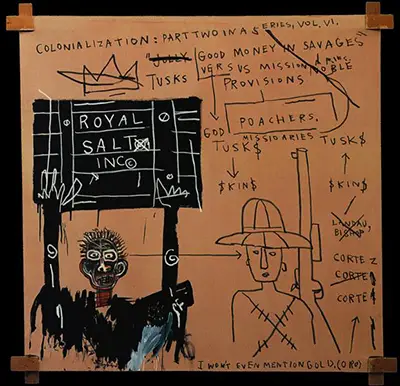Empire and Slavery are the two main themes of this artwork, and we can easily identify elements of those topics within this composition. We find a very clear comparison between the 'native' as the artist describes, and then what appears to be a colonial figure with hat and gun. There is then a considerable amount of writing which continues to draw on these issues. Basquiat regularly spoke out about the oppression of his people, as he saw it, and this painting is one of the most obvious references to it. It was rare for him to include portraits of white people within his paintings, and in most cases they would have a negative representation because of the types of historical and social commentary that he would deliver within many of his paintings.
Basquiat's life was turbulent from the off, and it is unsurprising that he sought unhealthy pastimes in order to try to soften the impact of these difficult circumstances. Thankfully he would eventually find art and use it as a means to self-expression that would help him to overcome some of the problems from his past. One can see his roots within much of his work, from his cultural heritage to the experiences that he would have had growing up at that time in the US. Even today many of the same issues, broadly speaking, are foremost in our minds and continue to drive debate, even public policy. Things may have moved on, but many issues still remain. He helped in bringing these topics to our attention in a way that was accessible and very genuine. Others merely admired the style of his work, whilst others flocked most to the content that he delivered.
The artist would leave behind a huge number of paintings and drawings from his career, with some of the best including La Hara, Boy and Dog in a Johnnypump and King Alphonso. Each piece would be entirely unique, but there were symbols which would re-appear across several items, and these would become signature elements of his oeuvre. Today there have been greater attempts to explain and understand the meanings of these recurring elements, sometimes with the different variations placed together for greater context. There was also a large use of other content which was much harder to pin down, with some very obscure references from popular culture and also historical events from many centuries past. Basquiat was an artist who keeps us on our toes as we dive deeper into his career, with all manner of different messages lying behind his Abstract Expressionist compositions.


